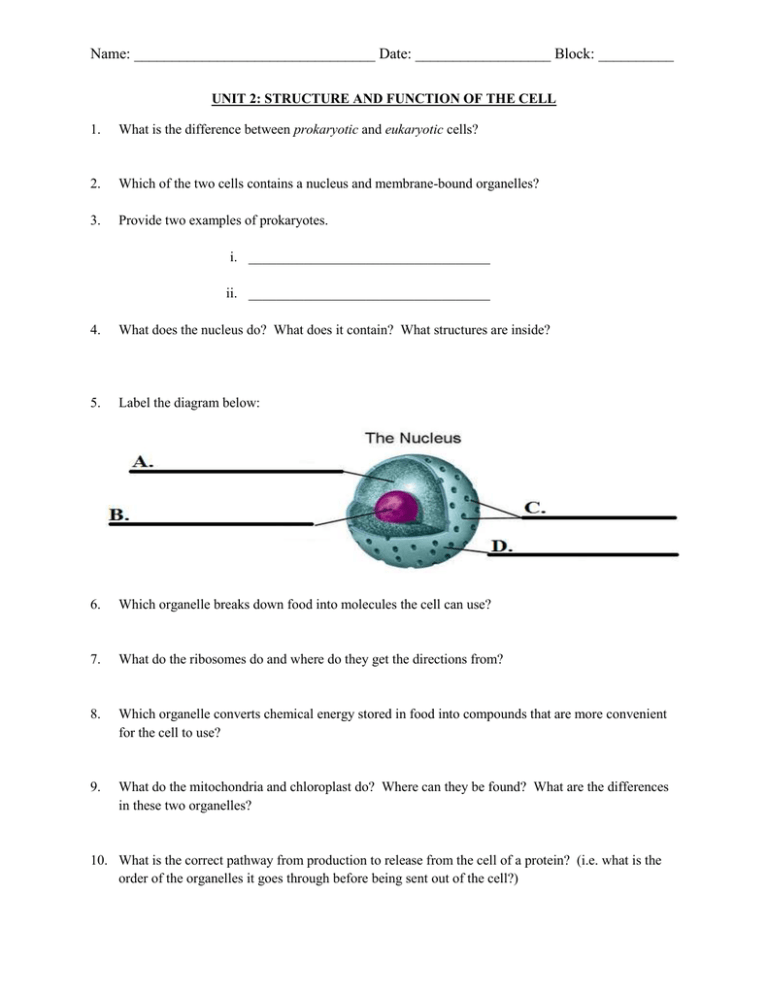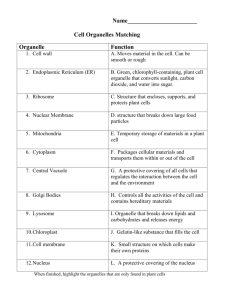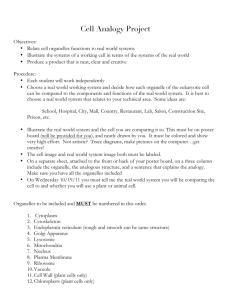Name: ________________________________ Date: __________________ Block: __________
advertisement

Name: ________________________________ Date: __________________ Block: __________ UNIT 2: STRUCTURE AND FUNCTION OF THE CELL 1. What is the difference between prokaryotic and eukaryotic cells? 2. Which of the two cells contains a nucleus and membrane-bound organelles? 3. Provide two examples of prokaryotes. i. ___________________________________ ii. ___________________________________ 4. What does the nucleus do? What does it contain? What structures are inside? 5. Label the diagram below: 6. Which organelle breaks down food into molecules the cell can use? 7. What do the ribosomes do and where do they get the directions from? 8. Which organelle converts chemical energy stored in food into compounds that are more convenient for the cell to use? 9. What do the mitochondria and chloroplast do? Where can they be found? What are the differences in these two organelles? 10. What is the correct pathway from production to release from the cell of a protein? (i.e. what is the order of the organelles it goes through before being sent out of the cell?) Name: ________________________________ Date: __________________ Block: __________ 11. What organelles are found only in plant cells and not animal cells? Name one additional difference pertaining to the quantity of mitochondria in each cell type (plant and animal). 12. What is the cytoskeleton? What does it do? What makes it up? 13. Which two structures carry out cell locomotion (movement)? 14. What is the cell wall? Where is it found? What type of cell? What is the main purpose? 15. What cell type (plant or animal) can a cell membrane be found in? What cell type can a cell wall be found in? 16. What organelle protects the cell from the environment? 17. How does the cell membrane move things in and out? 18. What is a channel protein and what process does it help? 19. What is diffusion? How does it work (i.e. what is the driving force behind diffusion?)? 20. What would happen to the movement of molecules across a membrane is the concentration is the same on the inside and outside? 21. Passive transport is _________________________________________________________ __________________________________________________________________________ and Active transport is ______________________________________________________ ________________________________________________What is the major difference?!?! 22. What is osmosis? How does it work? Explain this process with the observation made during the gummy bear demonstration. Name: ________________________________ Date: __________________ Block: __________ 23. What will happen to an animal cell that is surrounded by fresh water? 24. What is isotonic? What is hypotonic? What is hypertonic? Draw a picture of each and explain this process using the gummy bear demonstration. 25. What does Cell Specialization mean? 26. The cells of multicellular organisms work together to perform _______________________. 27. Use the space provided to list the levels of organization in a multicellular organism from the simplest level to the most complex level. 28. What do cell walls do and how is this beneficial to cells that come into contact with water? 29. Using the following figure, label each organelle and describe its function. A. _____________________________ B. _____________________________ C. _____________________________ D. _____________________________ E. _____________________________ F. _____________________________ G. _____________________________ H. _____________________________ I. _____________________________ 30. How do plants “drink,” meaning how do they pull water up their stems? Name: ________________________________ Date: __________________ Block: __________ 31. Using the picture below, answer the following questions and particles moving across a boundary. The membrane between the solutions is permeable to both the circle particles and the triangle particles. Side A Side B Selectively permeable membrane Describe the movement of the circles over time. Describe the movement of the triangles over time. Answer the following two questions FULLY and in COMPLETE SENTENCES. These are excellent essay questions. 32. Compare and contrast the structure and function of the cell wall with that of the cell membrane. 33. How do facilitated diffusion and active transport differ?









